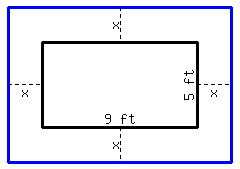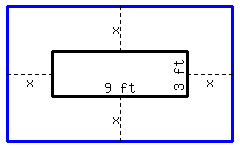Section 8.1 Solving Quadratic Equations by Factoring
¶We have learned how to factor trinomials like \(x^2+5x+6\) into \((x+2)(x+3)\text{.}\) This skill is needed to solve an equation like \(x^2+5x+6=0\text{,}\) which is a quadratic equation. A quadratic equation is is an equation in the form \(ax^2+bx+c=0\) with \(a\neq0\text{.}\) We also consider equations such as \(x^2=x+3\) and \(5x^2+3= (x+1)^2 + (x + 1)(x-3)\) to be quadratic equations, because we can expand any multiplication, add or subtract terms from both sides, and combine like terms to get the form \(ax^2+bx+c=0\text{.}\) The form \(ax^2+bx+c=0\) is called the standard form of a quadratic equation.
Before we begin exploring the method of solving quadratic equations by factoring, we'll identify what types of equations are quadratic and which are not.
Checkpoint 8.1.2
Now we'll look at an application that demonstrates the need and method for solving a quadratic equation by factoring.
Nita is in a physics class that launches a tennis ball from a rooftop \(80\) feet above the ground. They fire it directly upward at a speed of \(64\) feet per second and measure the time it takes for the ball to hit the ground below. We can model the height of the tennis ball, \(h\text{,}\) in feet, with the quadratic equation
where \(t\) represents the time in seconds after the launch. Using the model we can predict when the ball will hit the ground.
The ground has a height of \(0\text{,}\) or \(h=0\text{.}\) We will substitute \(0\) for \(h\) in the equation and we have
We need to solve this quadratic equation for \(t\) to find when the ball will hit the ground.
The key strategy for solving a linear equation is to separate the variable terms from the constant terms on either side of the equal sign. It turns out that this same method will not work for quadratic equations. Fortunately, we already have spent a good amount of time discussing a method that will work: factoring. If we can factor the polynomial on the left-hand side, we will be on the home stretch to solving the whole equation.
We will look for a common factor first, and see that we can factor out \(-16\text{.}\) Then we can finish factoring the trinomial:
In order to finish solving the equation, we need to understand the following property. This property explains why it was incredibly important to \(not\) move the \(80\) in our example over to the other side of the equation before trying to factor.
Fact 8.1.4 Zero Product Property
If the product of two or more numbers is equal to zero, then at least one of the numbers must be zero.
One way to understand this property is to think about the equation \(a\cdot b=0\text{.}\) Maybe \(b=0\text{,}\) because that would certainly cause the equation to be true. But suppose that \(b\neq0\text{.}\) Then it is safe to divide both sides by \(b\text{,}\) and the resulting equation says that \(a=0\text{.}\) So no matter what, either \(a=0\) or \(b=0\text{.}\)
To understand this property more, let's look at a few products:
When none of the factors are \(0\text{,}\) the result is never \(0\text{.}\) The only way to get a product of \(0\) is when one of the factors is \(0\text{.}\) This property is unique to the number \(0\) and can be used no matter how many numbers are multiplied together.
Now we can see the value of factoring. We have three factors in our equation
The first factor is the number \(-16\text{.}\) The second and third factors, \(t+1\) and \(t-5\text{,}\) are expressions that represent numbers. Since the product of the three factors is equal to \(0\text{,}\) one of the factors must be zero.
Since \(-16\) is not \(0\text{,}\) either \(t+1\) or \(t-5\) must be \(0\text{.}\) This gives us two equations to solve:
We have found two solutions, \(-1\) and \(5\text{.}\) A quadratic expression will have at most two linear factors, not including any constants, so it can have up to two solutions.
Let's check each of our two solutions \(-1\) and \(5\text{:}\)
We have verified our solutions. While there are two solutions to the equation, the solution \(-1\) is not relevant to this physics model because it is a negative time which would tell us something about the ball's height before it was launched. The solution \(5\) does make sense. According to the model, the tennis ball will hit the ground \(5\) seconds after it is launched.
Subsection 8.1.1 Further Examples
We'll now look at further examples of solving quadratic equations by factoring. The general process is outlined here:
Process 8.1.5 Solving Quadratic Equations by Factoring
- Simplify
Simplify the equation using distribution and by combining like terms.
- Isolate
Move all terms onto one side of the equation so that the other side has \(0\text{.}\)
- Factor
Factor the quadratic expression.
- Apply the Zero Product Property
Apply the Zero Product Property.
- Solve
Solve the equation(s) that result after the zero product property was applied.
Example 8.1.6
Solve \(x^2-5x-14=0\) by factoring.
The solutions are \(-2\) and \(7\text{,}\) so the solution set is written as \(\{-2, 7\}.\)
If the two factors of a polynomial happen to be the same, the equation will only have one solution. Let's look at an example of that.
Example 8.1.7 A Quadratic Equation with Only One Solution
Solve \(x^2-10x+25=0\) by factoring.
The solution is \(5\text{,}\) so the solution set is written as \(\{5\}\text{.}\)
Example 8.1.8 Factor Out a Common Factor
Solve \(5x^2+55x+120=0\) by factoring.
Note that the terms are all divisible by \(5\text{,}\) so we can factor that out to start.
The solution set is \(\{-8, -3\}\text{.}\)
Example 8.1.9 Factoring Using the AC Method
Solve \(3x^2-7x+2=0\) by factoring.
Recall that we multiply \(3\cdot2=6\) and find a factor pair that multiplies to \(6\) and adds to \(-7\text{.}\) The factors are \(-6\) and \(-1\text{.}\) We use the two factors to replace the middle term with \(-6x\) and \(-x\text{.}\)
The solution set is \(\left\{\frac{1}{3}, 2\right\}\text{.}\)
So far the equations have been written in standard form, which is
If an equation is not given in standard form then we must rearrange it in order to use the Zero Product Property.
Example 8.1.10 Writing in Standard Form
Solve \(x^2-10x=24\) by factoring.
There is nothing like the Zero Product Property for the number \(24\text{.}\) We must have a \(0\) on one side of the equation to solve quadratic equations using factoring.
The solution set is \(\{-2, 12\}\text{.}\)
Example 8.1.11 Writing in Standard Form
Solve \((x+4)(x-3)=18\) by factoring.
Again, there is nothing like the Zero Product Property for a number like \(18\text{.}\) We must expand the left side and subtract \(18\) from both sides.
The solution set is \(\{-6, 5\}\text{.}\)
Example 8.1.12 A Quadratic Equation with No Constant Term
Solve \(2x^2=5x\) by factoring.
It may be tempting to divide both sides of the equation by \(x\text{.}\) But \(x\) is a variable, and for all we know, maybe \(x=0\text{.}\) So it is not safe to divide by \(x\text{.}\) As a general rule, never divide an equation by a variable in the solving process. Instead, we will put the equation in standard form.
We can factor out \(x\text{.}\)
\begin{align*} x(2x-5)\amp=0 \end{align*}The solution set is \(\left\{0, \frac{5}{2}\right\}\text{.}\) In general, if a quadratic equation does not have a constant term, then \(0\) will be one of the solutions.
Example 8.1.13 Factoring a Special Polynomial
Solve \(x^2=9\) by factoring.
We can put the equation in standard form and use factoring. In this case, we find a difference of squares.
The solution set is \(\{-3, 3\}\text{.}\)
Example 8.1.14 Solving an Equation with a Higher Degree
Solve \(2x^3-10x^2-28x=0\) by factoring.
Although this equation is not quadratic, it does factor so we can solve it by factoring.
The solution set is \(\{-2, 0, 7\}\text{.}\)
Subsection 8.1.2 Applications
Example 8.1.15 Kicking it on Mars
Some time in the recent past, Filip traveled to Mars for a vacation with his kids, Henrik and Karina, who wanted to kick a soccer ball around in the comparatively reduced gravity. Karina stood at point \(K\) and kicked the ball over her dad standing at point \(F\) to Henrik standing at point \(H\text{.}\) The height of the ball off the ground, \(h\) in feet, can be modeled by the equation \(h=-0.01\left(x^2-70x-1800\right)\text{,}\) where \(x\) is how far to the right the ball is from Filip. Note that distances to the left of Filip will be negative.
Find out how high the ball was above the ground when it passed over Filip's head.
Find the distance from Karina to Henrik.
-
The ball was neither left nor right of Filip when it went over him, so \(x=0\text{.}\) Plugging that value into our equation for \(x\text{,}\)
\begin{align*} h\amp=-0.01\left(0^2-70(0)-1800\right)\\ \amp=-0.01(-1800)\\ \amp=18 \end{align*}It seems that the soccer ball was \(18\) feet above the ground when it flew over Filip.
-
The distance from Karina to Henrik is the same as the distance from point \(K\) to point \(H\text{.}\) These are the horizontal intercepts of the graph of the given formula: \(h=-0.01\left(x^2-70x-1800\right)\text{.}\) To find the horizontal intercepts, set \(h=0\) and solve for \(x\text{.}\)
\begin{align*} 0=-0.01\left(x^2-70x-1800\right)\\ \end{align*}Note that we can divide by \(-0.01\) on both sides of the equation to simplify.
\begin{align*} 0\amp=x^2-70x-1800\\ 0\amp=(x-90)(x+20)\\ \end{align*}So, either:
\begin{align*} x-90\amp=0\amp\text{or}\amp\amp x+20\amp=0\\ x\amp=90\amp\text{or}\amp\amp x\amp=-20 \end{align*}Since the \(x\)-values are how far right or left the points are from Filip, Karina is standing \(20\) feet left of Filip and Henrik is standing \(90\) feet right of Filip. Thus, the two kids are \(110\) feet apart.
Example 8.1.18 An Area Application
Rajesh has a hot tub and he wants to build a deck around it. The hot tub is 7 ft by 5 ft and it is covered by a roof that is 99 ft2. How wide can he make the deck so that it will be covered by the roof?
We will define \(x\) to represent the width of the deck (in feet). Here is a diagram to help us understand the scenario.
The overall length is \(7+2x\) feet, because Rajesh is adding \(x\) feet on each side. Similarly, the overall width is \(5+2x\) feet.
The formula for the area of a rectangle is \(\text{area}=\text{length}\cdot\text{width}\text{.}\) Since the total area of the roof is 99 ft2, we can write and solve the equation:
Since a length cannot be negative, we take \(x=2\) as the only applicable solution. Rajesh should make the deck 2 ft wide on each side to fit under the roof.
Subsection 8.1.3 Exercises
Warmup and Review
1
Factor the given polynomial.
\(8r+56=\)
2
Factor the given polynomial.
\(5r+10=\)
3
Factor the given polynomial.
\({t^{2}-7t-30}=\)
4
Factor the given polynomial.
\({t^{2}-3t-70}=\)
5
Factor the given polynomial.
\({2t^{2}-13t+21}=\)
6
Factor the given polynomial.
\({3x^{2}-11x+8}=\)
7
Factor the given polynomial.
\({54x^{2}+9x+54}=\)
8
Factor the given polynomial.
\({24y^{2}+6y+48}=\)
9
Factor the given polynomial.
\({121y^{4}-144}=\)
10
Factor the given polynomial.
\({64r^{4}-25}=\)
Solve Quadratic Equations by Factoring
11
Solve the equation.
\((x+4)(x - 7) = 0\)
12
Solve the equation.
\((x+7)(x+9) = 0\)
13
Solve the equation.
\({-74\!\left(x+8\right)\!\left(11x-7\right)} = 0\)
14
Solve the equation.
\({-60\!\left(x+10\right)\!\left(5x-1\right)} = 0\)
15
Solve the equation.
\({x^{2}+10x+9} = 0\)
16
Solve the equation.
\({x^{2}+8x+15} = 0\)
17
Solve the equation.
\({x^{2}-2x-8} = 0\)
18
Solve the equation.
\({x^{2}+7x-8} = 0\)
19
Solve the equation.
\({x^{2}-11x+30} = 0\)
20
Solve the equation.
\({x^{2}-14x+40} = 0\)
21
Solve the equation.
\({x^{2}+18x} = {-80}\)
22
Solve the equation.
\({x^{2}+13x} = {-36}\)
23
Solve the equation.
\({x^{2}+9x} = {10}\)
24
Solve the equation.
\({x^{2}-2x} = {63}\)
25
Solve the equation.
\({x^{2}-15x} = {-56}\)
26
Solve the equation.
\({x^{2}-8x} = {-7}\)
27
Solve the equation.
\({x^{2}} = {2x}\)
28
Solve the equation.
\({x^{2}} = {-x}\)
29
Solve the equation.
\({7x^{2}} = {-63x}\)
30
Solve the equation.
\({8x^{2}} = {-16x}\)
31
Solve the equation.
\({9x^{2}} = {5x}\)
32
Solve the equation.
\({10x^{2}} = {-9x}\)
33
Solve the equation.
\({x^{2}-4x+4}=0\)
34
Solve the equation.
\({x^{2}-6x+9}=0\)
35
Solve the equation.
\({x^{2}}={8x-16}\)
36
Solve the equation.
\({x^{2}}={12x-36}\)
37
Solve the equation.
\({49x^{2}}={-42x-9}\)
38
Solve the equation.
\({4x^{2}}={-28x-49}\)
39
Solve the equation.
\({5x^{2}}={-36x-36}\)
40
Solve the equation.
\({5x^{2}}={-52x-20}\)
41
Solve the equation.
\({x^{2}-100} = 0\)
42
Solve the equation.
\({x^{2}-81} = 0\)
43
Solve the equation.
\({9x^{2}-1}=0\)
44
Solve the equation.
\({16x^{2}-81}=0\)
45
Solve the equation.
\({9x^{2}}={16}\)
46
Solve the equation.
\({36x^{2}}={1}\)
47
Solve the equation.
\({x\!\left(x-5\right)} = {36}\)
48
Solve the equation.
\({x\!\left(x+1\right)} = {30}\)
49
Solve the equation.
\({x\!\left(5x+62\right)}={-120}\)
50
Solve the equation.
\({x\!\left(5x+54\right)}={-40}\)
51
Solve the equation.
\({\left(x-7\right)\!\left(x-1\right)} = {-8}\)
52
Solve the equation.
\({\left(x+2\right)\!\left(x+4\right)} = {3}\)
53
Solve the equation.
\({\left(x+2\right)\!\left(4x-7\right)} = {6+3x^{2}}\)
54
Solve the equation.
\({\left(x-2\right)\!\left(2x-3\right)} = {x^{2}-6}\)
55
Solve the equation.
\({x\!\left(x+4\right)}={2x-1}\)
56
Solve the equation.
\({x\!\left(x+12\right)}={3\!\left(2x-3\right)}\)
57
Solve the equation.
\({64x^{2}+48x+9}=0\)
58
Solve the equation.
\({81x^{2}+198x+121}=0\)
59
Solve the equation.
\({\left(x+7\right)\!\left(x^{2}+16x+60\right)} = 0\)
60
Solve the equation.
\({\left(x-5\right)\!\left(x^{2}+3x+2\right)} = 0\)
61
Solve the equation.
\({x\!\left(x^{2}-4\right)} = 0\)
62
Solve the equation.
\({x\!\left(x^{2}-16\right)} = 0\)
63
Solve the equation.
\({x^{3}-10x^{2}+16x} = 0\)
64
Solve the equation.
\({x^{3}+15x^{2}+54x} = 0\)
Quadratic Equation Application Problems
65
There is a rectangular lot in the garden, with \({9\ {\rm ft}}\) in length and \({5\ {\rm ft}}\) in width. You plan to expand the lot by an equal length around its four sides, and make the area of the expanded rectangle \({117\ {\rm ft^{2}}}\text{.}\) How long should you expand the original lot in four directions?
You should expand the original lot by in four directions.
66
There is a rectangular lot in the garden, with \({9\ {\rm ft}}\) in length and \({3\ {\rm ft}}\) in width. You plan to expand the lot by an equal length around its four sides, and make the area of the expanded rectangle \({135\ {\rm ft^{2}}}\text{.}\) How long should you expand the original lot in four directions?
You should expand the original lot by in four directions.
67
Two numbers’ sum is \(16\text{,}\) and their product is \(63\text{.}\) Find these two numbers.
These two numbers are .
68
Two numbers’ sum is \(4\text{,}\) and their product is \(-60\text{.}\) Find these two numbers.
These two numbers are .
69
A rectangle’s base is \({5\ {\rm cm}}\) longer than its height. The rectangle’s area is \({50\ {\rm cm^{2}}}\text{.}\) Find this rectangle’s dimensions.
The rectangle’s height is .
The rectangle’s base is .
70
A rectangle’s base is \({8\ {\rm cm}}\) longer than its height. The rectangle’s area is \({65\ {\rm cm^{2}}}\text{.}\) Find this rectangle’s dimensions.
The rectangle’s height is .
The rectangle’s base is .
71
A rectangle’s base is \({8\ {\rm in}}\) shorter than three times its height. The rectangle’s area is \({3\ {\rm in^{2}}}\text{.}\) Find this rectangle’s dimensions.
The rectangle’s height is .
The rectangle’s base is .
72
A rectangle’s base is \({3\ {\rm in}}\) shorter than twice its height. The rectangle’s area is \({9\ {\rm in^{2}}}\text{.}\) Find this rectangle’s dimensions.
The rectangle’s height is .
The rectangle’s base is .
Challenge
73
Give an example of a cubic equation that has three solutions: one solution is \(x = 6\text{,}\) the second solution is \(x= -4\text{,}\) and the third solution is \(x = \frac{2}{3} \text{.}\)
74
Solve for \(x\) in the equation \(27x^{14}-3x^{12} = 0 \text{.}\)


